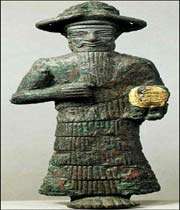History of Iran: Elamite Empire (2500 - 644 BCE)
The Iranian Plateau did not experience the rise of urban, literate civilization in the late 4th and early 3rd millennia on the Mesopotamian pattern but the lowland Khuzestan did. It was the Elamite Civilization.
Geographically, Elam included more than Khuzestan; it was a combination of the lowlands and the immediate highland areas to the north and east. Elamite strength was based on an ability to hold these various areas together under a coordinated government that permitted the maximum interchange of the natural resources unique to each region. Traditionally this was done through a federated governmental structure.
Closely related to that form of government was the Elamite system of inheritance and power distribution. The normal pattern of government was that of an overlord ruling over vassal princes. In earliest times the overlord lived in Susa, which functioned as a federal capital. With him ruled his brother closest in age, the viceroy, who usually had his seat of government in the native city of the currently ruling dynasty. This viceroy was heir presumptive to the overlord. Yet a third official, the regent or prince of Susa (the district), shared power with the overlord and the viceroy. He was usually the overlord"s son or, if no son was available, his nephew. On the death of the overlord, the viceroy became overlord. The prince of Susa remained in office, and the brother of the old viceroy nearest to him in age became the new viceroy. Only if all brothers were dead was the prince of Susa promoted to viceroy, thus enabling the overlord to name his own son (or nephew) as the new prince of Susa. Such a complicated system of governmental checks, balances, and power inheritance often broke down despite bilateral descent and levirate marriage (i.e., the compulsory marriage of a widow to her deceased husband"s brother).

What is remarkable is how often the system did work; it was only in the Middle and Neo-Elamite periods that sons more often succeeded fathers to power.